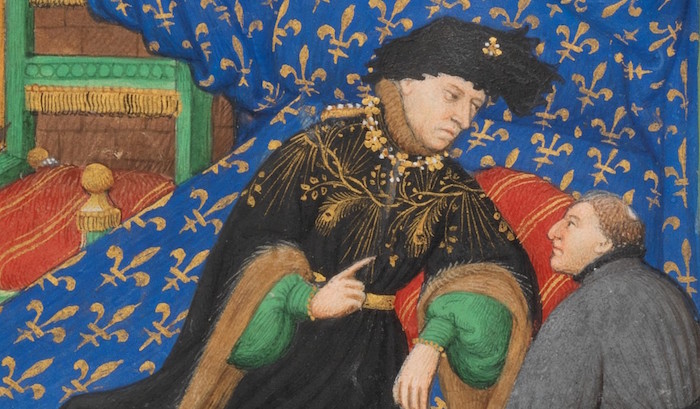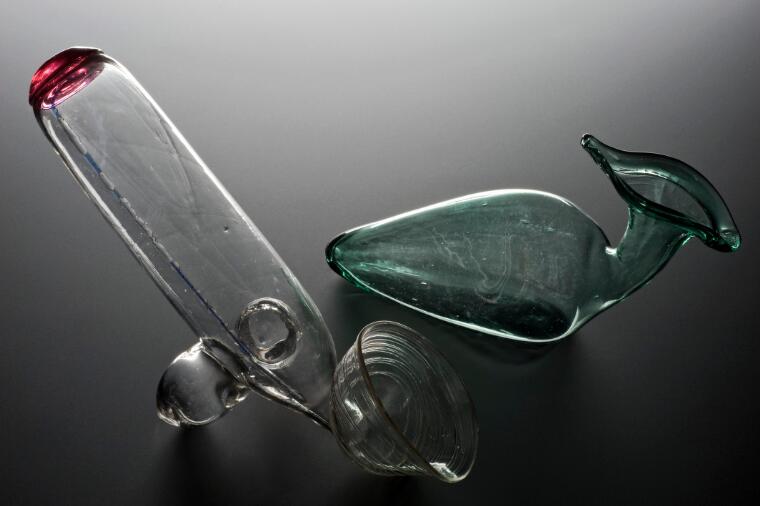The glass delusion was a weird pathology common in the late Middle Ages and Renaissance where the afflicted believed they were made of glass. It was also popular in literature, with some interesting changes to make it more suitable for fiction. The whole thing – history and fiction both – is super gameable!
This post is brought to you by beloved Patreon backer Arthur Brown. Thanks for helping keep the lights on! If you want to help keep this blog going alongside Arthur, head over to the Patreon page – and thank you!

Someone suffering from the glass delusion might believe they had an otherwise-ordinary body that was nonetheless made of glass. They might live a fairly ordinary life, except for taking extraordinary precautions to keep from shattering. King Charles the Mad of France (1368-1422) famously had this belief. He wore special padded clothes, stayed in bed as much as possible, and wouldn’t let people touch him. Nonetheless, he remained a capable administrator.Other sufferers believed their glass bodies were shaped like ordinary glass objects: that they were a glass bottle, an oil lamp, or even a urinal. Andreas Laurentius reported circa 1597 of a man who believed he had become a glass pitcher. In 1583, Thomaso Garzoni reported the case of a man who, believing he had become glass, tried to throw himself into a glazier’s furnace so he could be turned into a goblet.
Glass delusion is well-attested, with many cases recorded throughout the Middle Ages and the Renaissance. The majority of these cases were of people who believed only a certain part of their bodies was glass. A patient of Levinus Lemnius (1505-1568) wouldn’t sit down to poop for fear his butt would break when it touched the latrine. A niece of Cardinal Richelieu may have believed the same. Another case study by Andreas Laurentius believed his feet were made of glass and dared not walk. A 1607 alchemical text by Thomas Walkington mentioned a Venetian man convinced his shoulders and butt were glass, and who would not sit on chairs. The whole-body glass delusion was less common, but since it’s more dramatic, it tended to get the limelight.
There’s also a weird piss thing going on. One of the more common household uses of glass in the period was as urinals: little glass bottles invalids could pee in without getting out of bed. Some case studies record people with the glass delusion wanting others to pee in them. To a modern reader, that sure seems like a weird sex thing, but I don’t want to presume.

The delusion was popular in literature, with a great diversity of plays and short stories featuring characters suffering from the glass delusion. The most notable is El Licenciado Vidriera by Miguel de Cervantes, the Spanish author of Don Quixote. Cervantes’ protagonist came down with the glass delusion after taking a faulty love potion. He only ate food offered to him on the end of a stick, slept in haylofts, and walked in the middle of the street to avoid being shattered by falling roof tiles. The protagonist’s affliction was balanced by the appearance of great wit and cleverness that deserted him when he was finally cured. Puzzlingly, many of the details of Cervantes’ text mirror a case study written by Alfonso de Santa Cruz (the only such case study written by a Spaniard) about a French nobleman. Santa Cruz’s text was written around 1575 but not published until 1622 – after Cervantes was already dead. Could Cervantes have read an unpublished manuscript?

The literary versions of the glass delusion sometimes also featured an aversion to sunlight. The transparency of glass was great for metaphors: if you’re glass, people can see right through you, and whatever evils you contain are exposed to the light of God. Many literary sufferers of the delusion hid in the dark away from such exposure. Photophobia in literature also reflected contemporaneous ideas about mental health. The glass delusion was classed as a melancholy, caused by an excess of black bile, and melancholics in general were supposed to be photophobic.
Treatment for the glass delusion was rough. Royal physician Louis de Caseneuve reported in 1626 the case of a glass-maker who was cured of his glass delusion by a sound thrashing. The case study described by Alfonso de Santa Cruz was even more dramatic. The doctor prepared a bed of straw for the patient so he might lie there without risk of breaking. Then the doctor lit one corner of the bed on fire, fled the room, and locked the door. The patient leapt from the bed and beat upon the door with his limbs and head, begging to be released from this inferno. The patient’s domestic staff asked how, if he was made of glass, he could be striking the door with such force and not break. The patient agreed, begged once again to be saved from the flames, and was let out of the room. (There are textual reasons to suspect this this case study was fictionalized, but I believe the thrust of it is still useful.)
In classical and early medieval Europe, a different delusion seems to have been common. ‘Earthenware men’ believed they were made of fired clay, and were consequently fragile. As glass became more common in daily life, the glass delusion seems to have largely replaced the earthenware delusion.

The glass delusion is weird and wild – and therefore perfect for fictionalizing and dropping into your campaign! When filing the serial numbers off, it might be a good idea to avoid glass. Replacing the glass (or earthenware) in the delusion with something fragile and interesting from your setting makes the delusion feel more like it belongs in your fictional world and it lets you show off that cool part of the setting. In Star Wars, use Kyber crystals. In Glorantha, use clay tablets. In a modern-day setting, use aerogel or cell phone screens. In each case, you then get to take advantage of the cool properties of the material. Someone with a Kyber crystal delusion might possess (or believe they possess) unusual force powers. Someone who believes they’re made of clay tablets may be able to read the tablets and thereby possess secret knowledge. Someone made of aerogel may be deathly afraid of shattering but completely unafraid of fire or vacuum.
The glass delusion presents a wild plot hook for getting information from someone who doesn’t want to talk. Cervantes’ short story suggests that the glass delusion can be triggered by a particular potion. And the literary glass delusion involves the patient’s fear that others can ‘see through’ them. Cervantes provides no information on how to make that potion or turn that fear true. Neither does the published version of the text by Alfonso de Santa Cruz. But the unpublished version of that text – the one that Cervantes presumably drew from – that one might have the information you need, if you can only track it down. Of course, in your setting it’s in the library of a Spanish occultist who suffers from her own sets of delusions that make retrieving the manuscript all the more difficult.
Curing someone suffering from the glass delusion is a more straightforward plot hook. You might get tasked by a quest-giving friend or relative of the patient. Or maybe the patient is someone the party urgently needs to speak with, but they won’t receive visitors because of the delusion. If you break into their room, they panic, terrified the party is going to accidentally shatter them. Curing them is the only way to talk to them. And unfortunately, the only cures known to work probably won’t leave the patient well-disposed to the PCs.
To build on the earthenware-to-glass-delusion transition, maybe a new version of the condition is appearing in your setting. Just as the glass delusion replaced earthenware men, so too this new condition is replacing the glass delusion. The trouble is that this new condition is much worse! It’s tied to a new material in your fictional setting, and the properties of that material make people behave in dangerous and unpredictable ways. Can you find what’s causing this affliction and put an end to it?
Finally, you might make transporting a glass delusion patient a plot hook, or just use the condition as a cool way to make an NPC memorable!
Sources:
Or Hasson, Between Clinical Writing and Storytelling: Alfonso de Santa Cruz and the Peculiar Case of the Man Who Thought He Was Made of Glass, Hispanic Review (2017)
Gill Speak, An odd kind of melancholy: reflections on the glass delusion in Europe (1440-1680), History of Psychiatry (1990)
Gill Speak. El Licenciado Vidriera and the Glass Men of Early Modern Europe, The Modern Language Review (1990)
Alfred Garvin Engstrom, The Man Who Thought Himself Made of Glass, and Certain Related Images, Studies in Philology (1970)






